2.8 Installing Virtualized NetWare
This section provides the instructions for installing OES 2 NetWare as a guest OS.
2.8.1 Downloading the NetWare ISO and Preparing the License Files
For this release, you must install NetWare from the DVD .iso file copied to the server’s hard drive. If you intend to perform an unattended installation of NetWare, you must extract the required license files from the .iso file as well.
-
Using the Firefox* browser, access the OES 2 beta Web site (see your beta instructions for access information) and download the NW65SP7_OVL_DVD.iso file to your local hard drive.
Make a note of the .iso file’s location.
-
After the file downloads, click in the Firefox download dialog box.
-
Sort the list of files by and scroll to .
-
Select the .NFK and .NLF files, right-click them, and select .
-
Specify where you want the files placed, then click .
-
Click > and browse to the location where the license files were extracted.
-
Move the files out of the LICENSE folder, then delete the LICENSE folder.
-
Note where the license files are located. You need to create the response file in this same location.
If you want to create a response file to do a “silent” (unattended) installation of NetWare, continue with Section 2.8.2, Creating a Response File for an Unattended NetWare Installation. Otherwise, skip to Section 2.8.3, Creating a NetWare Virtual Machine and Installing Virtualized NetWare.
2.8.2 Creating a Response File for an Unattended NetWare Installation
OES 2 includes a YaST-based NetWare Response File Utility that asks you for information about the NetWare server you want to install. Basically, you answer the same questions as you would during a physical NetWare installation. When the time comes to run the NetWare Install program, the installation reads your responses from the file and proceeds without required any further intervention.
For more detailed information about creating a response file, see
Using the NetWare Response File Utility in YaST
in the
OES 2: NetWare Installation Guide
.
-
Open YaST and click > .
-
On the Select Install Type page, leave the install type set for . Do not change any other options. Click .
-
Click , specify a valid NetWare server name for the virtualized NetWare server and the IP address you want the virtualized server to use.
The IP address must be unique on the subnet just as it would be for a physical NetWare installation.
-
Click .
-
Click .
-
Specify the name of the OES 2 tree and a context for this server object.
-
In the field, specify the IP address of the OES 2 eDirectory server.
-
In the section, specify the admin information for the tree, then click .
-
Click , specify the eDirectory container where you want the NetWare license files stored, then click .
-
Click .
-
Specify the and information for the subnet and click .
-
Click > .
-
Click > .
If your tree has more than three servers, specify the valid SLP information before continuing.
-
Click , specify the DNS information, then click .
-
Click , select your time zone options, then click .
-
Click .
-
Leave the protocol set to TimeSync (do not select NTPv3), select , and specify the same time synchronization source as your eDirectory server uses, select if applicable, then click .
-
Click > .
-
Click > .
-
Click , select the preconfigured server pattern you want installed, then click .
-
If you select in the previous step, click , select the services you want installed, and click .
-
Click > > .
-
(Conditional) Depending on what products you selected for the server, click the headings and enter the required information until all the configuration options have been completed for the response file.
-
On the Save Response File page, specify a response filename, then browse to the directory where you stored your NetWare license files. The field should show a path that ends with a forward slash (/).
-
If you want the VM Manager to launch automatically after you exit the Response File Generator, select .
-
Specify the location of the Installation Source. In this case, browse to the DVD .iso file that you copied to the local server.
-
Click .
-
If you chose to automatically launch VM Manager in Step 25 above, click and skip to Step 5. Otherwise, continue with Section 2.8.3, Creating a NetWare Virtual Machine and Installing Virtualized NetWare.
2.8.3 Creating a NetWare Virtual Machine and Installing Virtualized NetWare
Follow these steps to create a NetWare VM and install virtualized NetWare.
-
Open YaST, then click > .
-
Read the Create a Virtual Machine welcome page, then click .
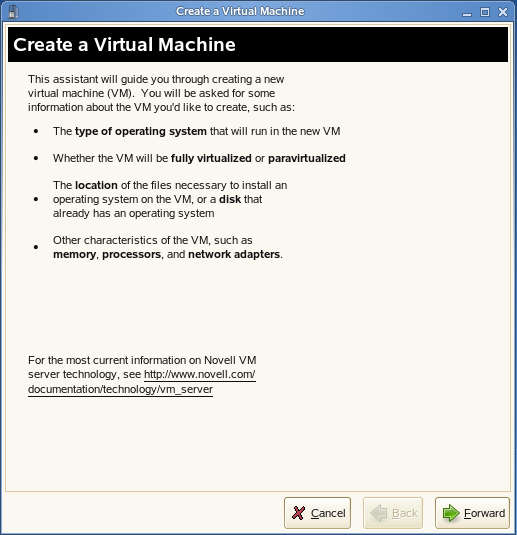
-
Select , then click .
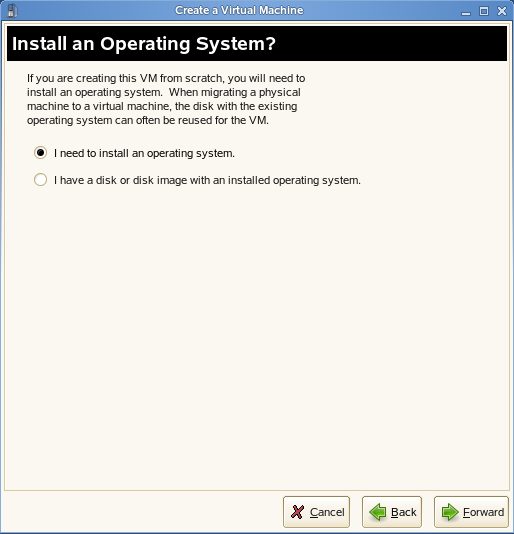
-
Select , then click .
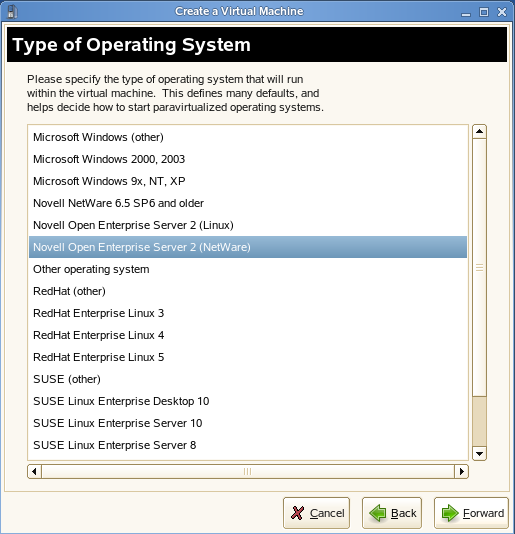
-
The Summary page appears, showing the settings to be used for the virtual machine. Make changes to the virtual machine setup as required for your server.
-
Name of Virtual Machine: Specify the name displayed for this virtual machine in the Virtual Machine Manager.
-
Hardware: Change the initial and maximum memory settings and add virtual processors.
NOTE:Do not set the initial memory setting less than the default of 512 MB. For best performance, the number of virtual processors should be less than or equal to the number of physical processors.
-
Disks: Create the virtual disks that the server will have access to. The default setting is a single 10 GB file for disk0.
When you create a virtual disk, make sure you have enough physical disk space on the host server’s hard drive to accommodate the maximum size of the virtual disk. If you do not select the sparse file option, a blank file of the selected size is created at the beginning of the virtual machine installation.
-
Network Adapters: Create virtual network adapters for the server. The default setting is a single paravirtualized network adapter.
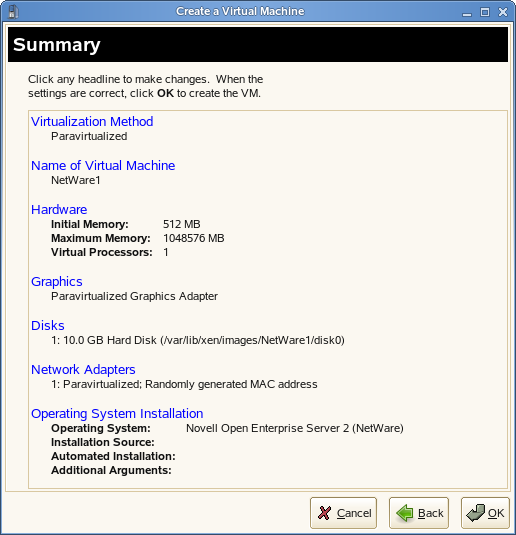
-
-
To specify the NetWare 6.5 SP7 DVD .iso file as the installation source:
-
Click the heading.
-
Click > .
-
Browse to the .iso file you downloaded to the local file system, then click > .
-
-
(Conditional) If you created a Response File that you want to use for the NetWare installation:
-
Click , then browse to and select the file you created in Section 2.8.2, Creating a Response File for an Unattended NetWare Installation.
-
Click > .
The Response File’s path and filename should be displayed in the Automated Installation field on the Summary page.
-
-
When you have the virtual machine settings the way you want them, click to proceed with the creation of the virtual machine and the installation of the virtual NetWare server.
A VNC viewer window appears, displaying the progress of the NetWare install program.
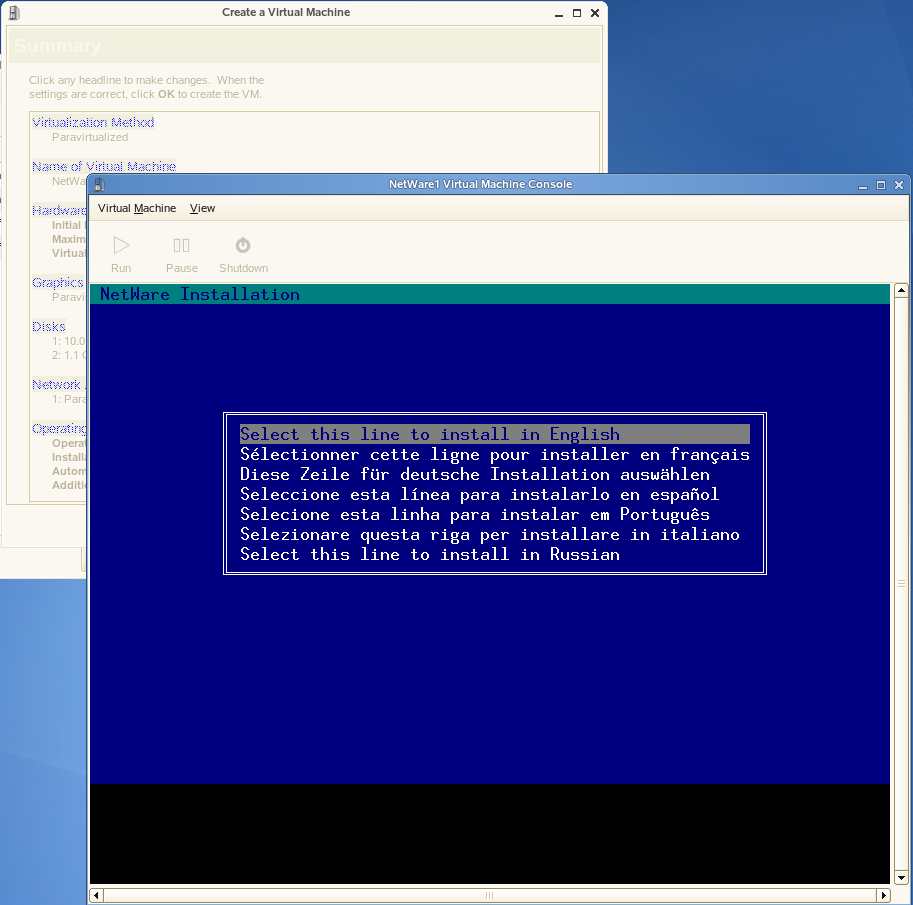
If you specified a response file, the installation uses the information you recorded in the response file. If a required parameter is missing in the response file, you are prompted to enter the desired values during the installation.
If you did not specify a response file, you must enter all of the installation information as you would for a physical NetWare installation. For detailed instructions, see
Starting the Installation Program
in the OES 2: NetWare Installation Guide .IMPORTANT:Do not close the VNC viewer window while the NetWare install program is running. Doing so prevents the installation from completing properly.